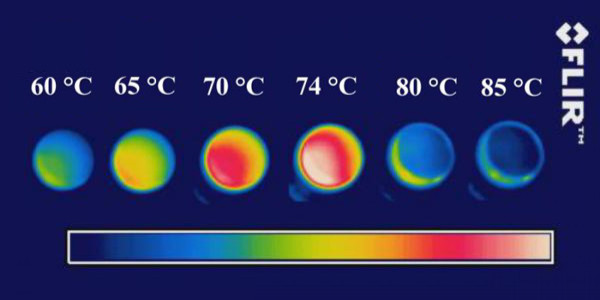Activate Heat-Cloaking Device! Scientists Make Substance That Looks Cool When It's Hot

Scientists have found a way to hide objects from heat-sensing devices by creating what seems like a paradox: a thin film that appears to grow colder as it heats up.
Normally, objects give off more light the hotter they are. That principle of “emissivity” is what allows night-vision goggles to pick out warm bodies in the dark -- they sense the infrared radiation coming off of a person or animal, which is much stronger than the radiation put out by colder things like buildings or plants.
But it might be possible to fool those night-vision goggles by shielding objects with materials that warp the emissivity principle. Harvard scientist Mikhail Kats and his colleagues were intrigued by the properties of a substance called vanadium dioxide, which undergoes a curious transformation when it reaches a temperature of 70 degrees Celsius (158 degrees Fahrenheit). At that point, the material switches from being an insulator of electricity to a conductor -- turning from something that hinders the flow of an electrical current to something that encourages the flow.
For their experiments, Kats and colleagues grew a thin film (very thin, actually -- 150 nanometers thick, or about a thousand times thinner than a human hair) of vanadium oxide on a little slab of sapphire. The gemstone was selected because it’s much easier to coax the film to develop.
Vanadium dioxide is “so crystalline, you can’t just grow that on any material,” Kats said in a phone interview. “Sapphire is a good base because it has roughly same spacing between its atoms” as vanadium dioxide.
When they put the sapphire-vanadium dioxide combination on a hot plate, trained an infrared camera on it and cranked up the temperature, a neat thing happened. As the team described in a paper published in Physical Review X, the material started glowing redder and redder in the infrared as it heated up, showing up as a deep crimson at 74 degrees Celsius. But when it passed that point, emissivity started going backward. At 80 degrees Celsius, the sample was down to a blue hue on the infrared camera, and stayed looking “cold” even when the hot plate got hotter.
“When we set out to do this particular experiment we knew what was looking for, what we planned to see,” Kats says. “Yet when we saw it work, it was still kind of a striking thing to see.”
With this kind of technology, it might be possible to cloak aircraft and other machines from heat-sensing devices. Since thermal radiation carries heat, the film could be used to control the temperatures of everything from houses to satellites -- either slowing down or speeding up the cooling process as needed.
But don’t expect a personal thermal shield just yet. At present, the heat-cloaking abilities of vanadium oxide only activate at scorching temperatures. It may be possible to adjust the material to change the transition point to a more-comfortable range, but for now, your dreams of a heat-masking suit of sapphire armor will have to wait.
“You don’t want to cover someone with something getting close to burning them,” Kats says.
SOURCE: Kats et al. “Vanadium dioxide as a natural disordered metamaterial: perfect thermal emission and large broadband negative differential thermal emittance.” Physical Review X, published online 21 October 2013.
© Copyright IBTimes 2025. All rights reserved.





















